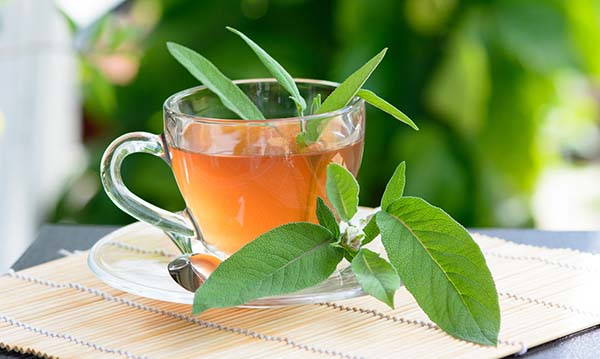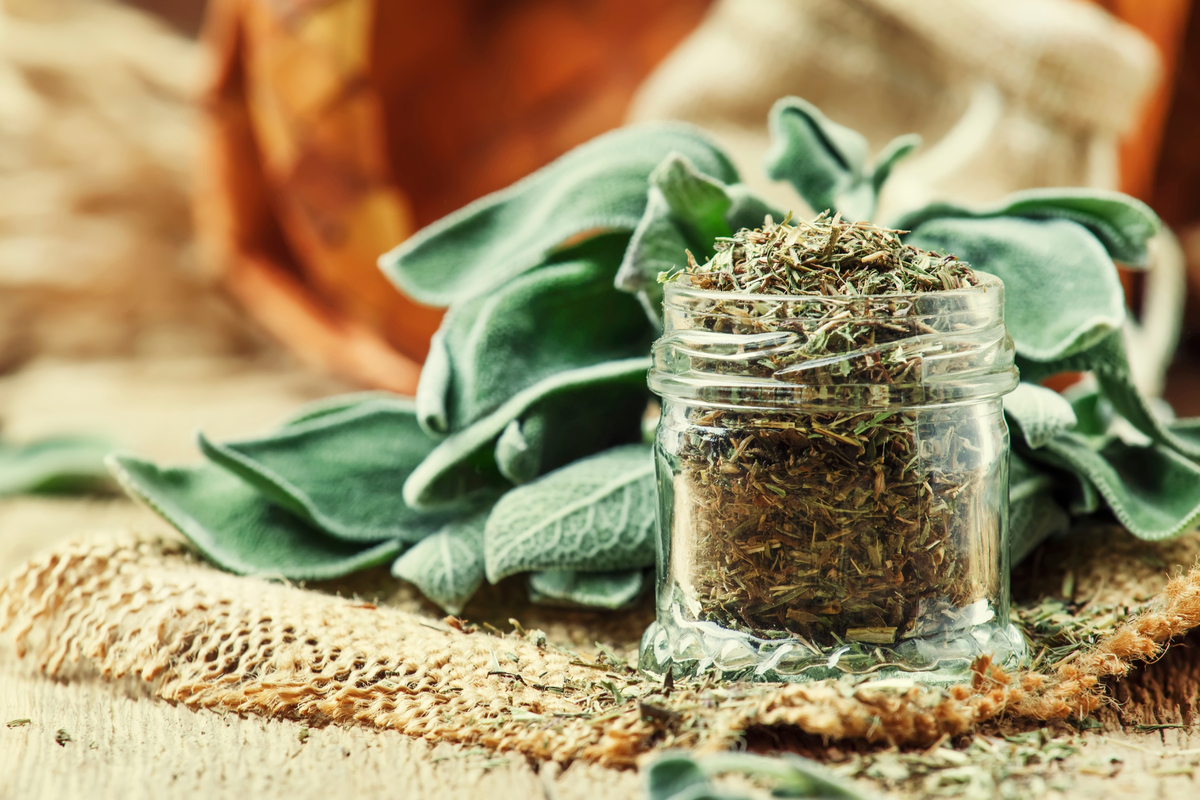Sage, not only in the kitchen! Find out how to use it to improve your health and beauty of skin or hair
The salvia it is an aromatic herb that we usually use in the kitchen, forgetting or underestimating its potential in the field of health and beauty. So we present 20 uses for your well-being and to improve the appearance of skin and hair.
Sage has been known since Roman times. It is an evergreen perennial plant typical of the Mediterranean and belonging to the Lamiaceae family.
Its name is already a whole program, in fact it derives from the Latin word “greetings” or “be healthy“. It is no coincidence that the overtime health properties of sage have made it a staple in traditional European and Chinese medicines. Moreover, thanks to its extraordinarily pleasant aroma, it is used as a fragrance in the production of soaps and cosmetics. And it is also for this reason known as the aromatic herb “friend of women”.
The many effects benefits of sage so are due to the presence in the plant of essential oils, vitamins and other compounds that contribute to improving the overall health of the body, including that of skin and hair.
So let’s find out the advantages it offers and how to use sage for small health and beauty problems.
Health benefits of sage
Sage to prevent diabetes
Several studies have shown that sage leaf extract has anti-hyperglycemic properties that is, it is able to lower blood glucose levels by blocking the release of this substance stored by the liver. However, more research is needed to validate this claim.
Sage to improve memory
Regular intake of sage can improve memory and information processing among people with Alzheimer’s. This could be because sage essential oil improves acetylcholinesterase (Ach) levels in the brain. This enzyme is able to promote concentration and helps in the treatment of memory loss associated with Alzheimer’s.
Sage against disorders related to the menstrual cycle
The beneficial effects of sage for women are mainly due to the action of some flavonoids that help rebalance the hormonal system. It can be useful in case of amenorrhea, other disorders related to the menstrual cycle but also in menopause where a positive effect has been noted in countering hot flashes.
Sage to improve memory and attention
Sage contains Thujone which is the GABA receptor and serotonin antagonist. In addition to improving concentration and attention, it helps to better cope with pain and depression.
Cardiovascular benefits
Sage contains a flavone known as salvigenin. Its vascular relaxing effect precisely provides some protection against heart disease.
How to use sage to get better

Infusion for the oral cavity and as a mouthwash
Sage has anti-inflammatory properties. The sage-based infusion can be used to rinse or gargle for inflammation of the oral cavity. Also excellent as a mouthwash after brushing teeth in case of gingivitis.
Infusion against digestive problems
Sage is a great stimulant tonic that can help treat stomach problems. Sage tea or infusion is particularly effective in this regard. Its carminative effect can remove indigestion symptoms by stimulating upper digestive secretions, bile flow, intestinal mobility and pancreatic function.
Infusion of sage against sore throat
Sage tea has been shown to be effective in treating sore throats. For this purpose and to alleviate the sore throat, you can boil a pinch of dried sage leaves in about 100 ml of water and infuse them for 15 minutes. Filter the preparation and use to gargle twice a day.
Against asthma and congestion of the mucous membranes
The anti-spasmodic effect of sage reduces the tension in the smooth muscles and for this reason it is a remedy that can be recommended for the inhalation of steam in the preventive phase of asthma. It is effective in removing mucosal congestion in the airways and preventing secondary infections.
Sage against excessive sweating
Taking dried leaf extract or sage leaf infusion can reduce sweating by up to 50%. Among other things, it is an excellent deodorant that dries sweat and helps eliminate body odor.
Essential oil against muscle pain and rheumatism
Sage essential oil can be used externally to soothe pain due for example to muscle stiffness, rheumatism or other neuralgic conditions. Spread the essential oil diluted in a cream directly on the painful area
Essential oil against stress
Sage oil in aromatherapy is used to treat nervousness, stress, fatigue, tiredness, headache and anxiety. It can be used spread in rooms or massaged on the body always first by diluting it in another vegetable oil.
How to use sage for skin beauty
Tonic against oily skin
Sage oil is an excellent tonic that helps regulate sebum production especially in the case of oily skin. You can make a homemade tonic by boiling a tablespoon of sage in about 250ml of water. Let it sit for 30 minutes and strain the mixture. After letting it cool, you can dab it on your face.
Infusion against acne and psoriasis
The antibacterial properties of sage prevent the occurrence of skin infections. This herb also possesses antiseptic and anti-inflammatory properties that help treat acne and relieve symptoms of eczema and psoriasis. The infusion, left to cool first, should always be used to pat the areas of skin affected by the problem.
Essential oil against eye wrinkles
The antioxidants present in sage protect against free radicals (which damage skin cells) and keep the signs of aging (wrinkles, blemishes, etc.) at bay. This herb is rich in calcium and vitamin A which aid in daily cell regeneration, minimizing and delaying the onset of wrinkles. You can use a drop or two of sage essential oil, always first diluted in a cream or in a carrier oil (such as sweet almond oil) on your eye area.
How to use sage for hair beauty
Serum against hair loss
Sage has been used since ancient times to combat hair loss. In fact, this plant contains beta-sitosterol, a compound that has been shown to be effective in the treatment of male pattern baldness. It is recommended to mix 3 to 4 drops of sage essential oil with an equal amount of rosemary and peppermint essential oil and dilute everything in 1 tablespoon of olive oil. Then massage the scalp with this mixture twice a day.
Infusion to strengthen the hair
Not only does it prevent it from falling out, sage in combination with rosemary is an excellent natural remedy for making hair thicker, shinier and stronger, revitalizing dry and dehydrated hair. All of this is possible as it improves the circulation of the scalp by providing more nourishment to the hair follicles. A sage and rosemary hair rinse can be prepared by boiling the two herbs in water.
Infusion for dull hair
The sage tea can be used to rinse the hair giving it more shine. You can make this by boiling 1 tablespoon of dried sage leaves in a cup of water. The same infusion also helps to avoid the problem of dandruff.
Infusion to darken the hair
Sage can be used to darken and intensify hair color. An infusion of leaves of this plant can help darken gray hair a little and also make brown or black hair more decisive and brilliant colors. You simply need to use it consistently as a final rinse after shampooing.
Lotion to promote styling
Sage can be used to make a lotion to make hair more manageable and improve its texture. Just combine a handful of sage leaves with the same amount of rosemary and boil them in about 200ml of water for 3 minutes. Let the herbs rest for a while, filter and put a small amount of this mixture on the hair, massaging it immediately before proceeding with the styling.
The benefits of sage are numerous, have you already experienced them?
On sage you may also be interested in:
The article incorporates published studies and recommendations from international institutions and / or experts. We make no claims in the medical-scientific field and we report the facts as they are. The sources are indicated at the end of each article
.
